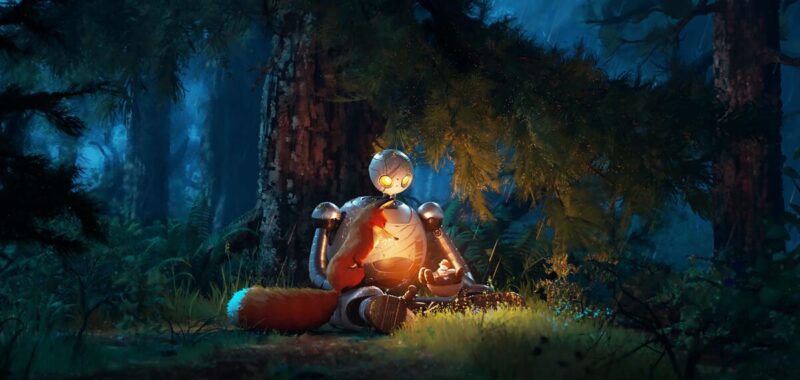“The Wild Robot” has a lot to say and its own way of saying it. It’s a big-studio animated feature that has its own look, feel and identity, wrapped around an unusual story with ample humor and plenty of emotion — all of it earned. The movie’s vocal performances, especially from leads Lupita Nyong’o and Pedro Pascal, are excellent. It’s lovely on the outside and on the inside.
In writer-director Chris Sanders’ adaptation of Peter Brown’s books, a shipment of household robots goes awry and one of them — ROZZUM Unit 7134, or “Roz” for short — washes up on a verdant isle populated by woodland creatures. When Roz (voiced by Nyong’o) is accidentally activated, she finds herself without humans to serve. She’s not programmed to interact with wildlife; she requires a directive. So she does the first thing that clues us in to the cleverness of the enterprise. She enters “Learning Mode” and goes dormant while nature grows around her and countless critters go about their business. When she reactivates, having observed the animals for some long period, she’s able to communicate with them, though they’re terrified of her.
In due time, she finds her directive through a tragic mishap and the sudden responsibility of caring for a very cute, orphaned gosling, Brightbill (Kit Connor). Roz’s new mission is to usher the baby bird to maturity in time to fly south with the other geese, and she attacks it with cheery aplomb and the help and/or machinations of Fink (Pascal), the slyest of foxes. There’s much more to the story beyond that brief sketch (including some well-executed action sequences), but that would be telling. And “The Wild Robot” deserves to surprise you.
You know you’re in for something different from the opening frames as the film’s painterly look is revealed. There are brushstrokes and smudges, as if the world were realized in pastels. It’s not slickly stylized, ironic or plasticized as so much current animation can be. Gentle colors can be exquisite. The filmmakers have said they were aiming for a “Miyazaki forest brought to life through the work of Claude Monet.” Whether they succeeded is up to the viewer, but there are moments of unexpected beauty — even magnificence — in the visuals.
Likewise, character movements aren’t marked by the almost campy, programmed, algorithmic feel that has become so common (think of the head tilt we’ve come to expect when a CG child pantomimes emotion). In “Wild Robot,” mannerisms and gestures feel organic, whether by a possum or, ironically, a robot. There’s delightful imagination in Roz’s movements as she endlessly adapts to her surroundings. We are completely keyed in to her feelings, her emotional journey, and she’s a robot with no facial expressions of which to speak. That’s a testament to how much is conveyed through action, atmosphere and Nyong’o’s warmly naïve vocal portrayal.
Nyong’o is tasked initially with playing, essentially, a cheery blank slate. Roz is programmed to be upbeat even as she encounters failure. She’s a being in search of meaning (“Did anyone order me?” she asks as the animals flee her), and earns our affection not only with earnestness, but willingness to evolve. Without the usual tools at Nyong’o’s disposal, the actor conveys urgency, dedication and, eventually, love. Even cynical moviegoers hardened by the rigidity of formula in so many other animated features will be hard-pressed not to root for self-sacrificing, determined and warm-circuited Roz. Nyong’o and the scene-stealing Pascal are ably supported by the likes of Bill Nighy, Catherine O’Hara, Mark Hamill and Matt Berry, vocalizing various animals on the island.
The journey is one of self-discovery for both robot and goose as they become fully realized versions of themselves. “The Wild Robot” is about the nature of family — the families we find — and about building community. But at its beating, beeping heart is a profound parenting parable akin to “The Giving Tree.” Like many humans who thought they fully understood how their lives would change once they had kids, Roz finds she must rewrite her programming to care for this child. Her daily dedication to those tasks evolves into something that, even embodied by circuitry and microchips encased in metal, can only be love.
In Brightbill’s trek toward self-sufficiency, there’s a bittersweet echo of the parent’s most important job, the one that never truly ends, but when it’s well done, it means goodbye to the life you’ve known together. All of it — the conflict, the adventure, the humor, the way we witness characters growing together — makes the film’s emotional payoffs feel genuine. Despite its machine-and-animal cast, “The Wild Robot” is a welcome step toward humanity for big-budget, studio animation.

